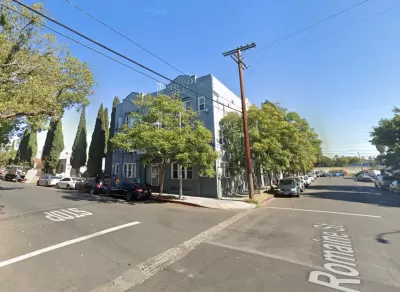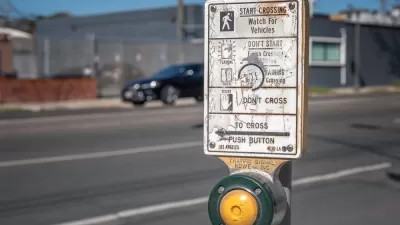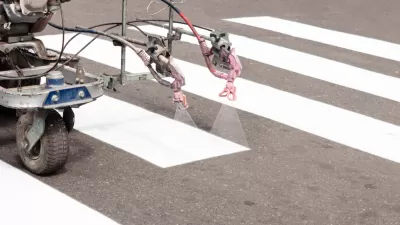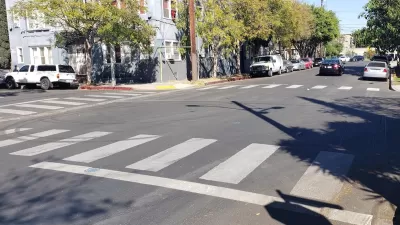A group claiming the city of Los Angeles fails to protect pedestrians is taking action on their own, painting a set of crosswalks at a busy residential intersection.

In a nod to tactical urbanism, an anonymous group calling itself Crosswalk Collective LA is taking on the pedestrian safety crisis by painting crosswalks themselves, reports Vanessa Romo. "A series of striped crosswalks suddenly appeared at a busy residential intersection, and the secretive group that claims it's behind the do-it-yourself project says it has more in the works."
"'We are a small group of community members who have tried for years to request crosswalks and other safe streets infrastructure the official way,' they told NPR in a statement." According to the Collective, "At every turn, we've been met with delays, excuses, and inaction from our city government, as well as active hostility to safe streets projects from sitting councilmembers."
With one pedestrian killed every three days in Los Angeles, the city's death rate is "four times the national average," the article states. The Collective's actions have spurred requests for guidance from activists in other cities.
City officials, meanwhile, aren't as thrilled. "LA Department of Transportation spokesman Colin Sweeney said the public's best bet to ensure safety measures are properly installed, is to go through the proper channels." As Romo notes, "The city has a history of quickly buffing out painted street and sidewalk DIY modifications, whether they're guerilla bike lanes or more artistic safety projects that highlight the city's deteriorating infrastructure." LADOT also claims that no requests for crosswalks at the intersection in question have been submitted to the department, and that requests are evaluated and installed where appropriate, but admit that the process can be excruciatingly slow.
FULL STORY: A secretive LA group has a new mission: paint untouched crosswalks

Alabama: Trump Terminates Settlements for Black Communities Harmed By Raw Sewage
Trump deemed the landmark civil rights agreement “illegal DEI and environmental justice policy.”

Study: Maui’s Plan to Convert Vacation Rentals to Long-Term Housing Could Cause Nearly $1 Billion Economic Loss
The plan would reduce visitor accommodation by 25% resulting in 1,900 jobs lost.

Why Should We Subsidize Public Transportation?
Many public transit agencies face financial stress due to rising costs, declining fare revenue, and declining subsidies. Transit advocates must provide a strong business case for increasing public transit funding.

Paris Bike Boom Leads to Steep Drop in Air Pollution
The French city’s air quality has improved dramatically in the past 20 years, coinciding with a growth in cycling.

Why Housing Costs More to Build in California Than in Texas
Hard costs like labor and materials combined with ‘soft’ costs such as permitting make building in the San Francisco Bay Area almost three times as costly as in Texas cities.

San Diego County Sees a Rise in Urban Coyotes
San Diego County experiences a rise in urban coyotes, as sightings become prevalent throughout its urban neighbourhoods and surrounding areas.
Urban Design for Planners 1: Software Tools
This six-course series explores essential urban design concepts using open source software and equips planners with the tools they need to participate fully in the urban design process.
Planning for Universal Design
Learn the tools for implementing Universal Design in planning regulations.
Smith Gee Studio
Alamo Area Metropolitan Planning Organization
City of Santa Clarita
Institute for Housing and Urban Development Studies (IHS)
City of Grandview
Harvard GSD Executive Education
Toledo-Lucas County Plan Commissions
Salt Lake City
NYU Wagner Graduate School of Public Service





























